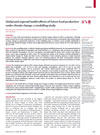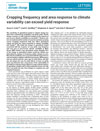-
What Makes Agriculture Vulnerable to Climate Change, and the Mortality Effects of Fruit and Vegetable Scarcity
June 23, 2016 By Adrienne Bober Gains in food production and increased awareness of global food security are threatened by looming losses due to climate change, according to a study published in The Lancet. Marco Springmann et al. calculate that climate change will lead to a 3.2 percent reduction in global food availability per person by 2050, driven by changes in weather patterns, increasing frequency of extreme weather, and potential social disruptions to food production like disease and conflict. Such a decline could lead to over 500,000 related deaths, primarily due to dietary and weight-related risk factors. The authors look beyond caloric availability to understand the health impacts of changing diet composition. Although effects vary by region, they conclude that even with reductions in red meat consumption, which is positive for health, a decline in fruit and vegetable availability would have significant negative impacts. Springmann et al. express the necessity of immediate climate change mitigation, but write that even a strong mitigation program would be unable to avoid nutrition scarcity deaths due to lagged effects. The authors therefore recommend strengthening public health programs dedicated to nutrition and diet counseling as an adaptation strategy.
Gains in food production and increased awareness of global food security are threatened by looming losses due to climate change, according to a study published in The Lancet. Marco Springmann et al. calculate that climate change will lead to a 3.2 percent reduction in global food availability per person by 2050, driven by changes in weather patterns, increasing frequency of extreme weather, and potential social disruptions to food production like disease and conflict. Such a decline could lead to over 500,000 related deaths, primarily due to dietary and weight-related risk factors. The authors look beyond caloric availability to understand the health impacts of changing diet composition. Although effects vary by region, they conclude that even with reductions in red meat consumption, which is positive for health, a decline in fruit and vegetable availability would have significant negative impacts. Springmann et al. express the necessity of immediate climate change mitigation, but write that even a strong mitigation program would be unable to avoid nutrition scarcity deaths due to lagged effects. The authors therefore recommend strengthening public health programs dedicated to nutrition and diet counseling as an adaptation strategy.  Using data from the Brazilian state of Mato Grosso, Avery S. Cohn et al. examine the vulnerability of agriculture to climate change and find roughly 70 percent of the change in output was determined by two indicators: the number of crops harvested per season and the area of cropland. These conclusions, published in Nature Climate Change, point to the importance of other agricultural indicators besides yield in determining where and how climate change will affect food security, the authors say. The number of crops harvested per season and area of cropland indicate past mismanagement and poor soil quality. Land is being abandoned or left unsown because the soil is no longer productive due to over-farming or lack of crop rotation. In order to keep up production, farmers are spreading onto previously unused land. This cycle, however, “may also result in a host of negative environmental impacts,” the authors write. “The output can be socially costly and could even compromise future crop production.”
Using data from the Brazilian state of Mato Grosso, Avery S. Cohn et al. examine the vulnerability of agriculture to climate change and find roughly 70 percent of the change in output was determined by two indicators: the number of crops harvested per season and the area of cropland. These conclusions, published in Nature Climate Change, point to the importance of other agricultural indicators besides yield in determining where and how climate change will affect food security, the authors say. The number of crops harvested per season and area of cropland indicate past mismanagement and poor soil quality. Land is being abandoned or left unsown because the soil is no longer productive due to over-farming or lack of crop rotation. In order to keep up production, farmers are spreading onto previously unused land. This cycle, however, “may also result in a host of negative environmental impacts,” the authors write. “The output can be socially costly and could even compromise future crop production.”Sources: The Lancet, Nature Climate Change.
 A Publication of the Stimson Center.
A Publication of the Stimson Center.





